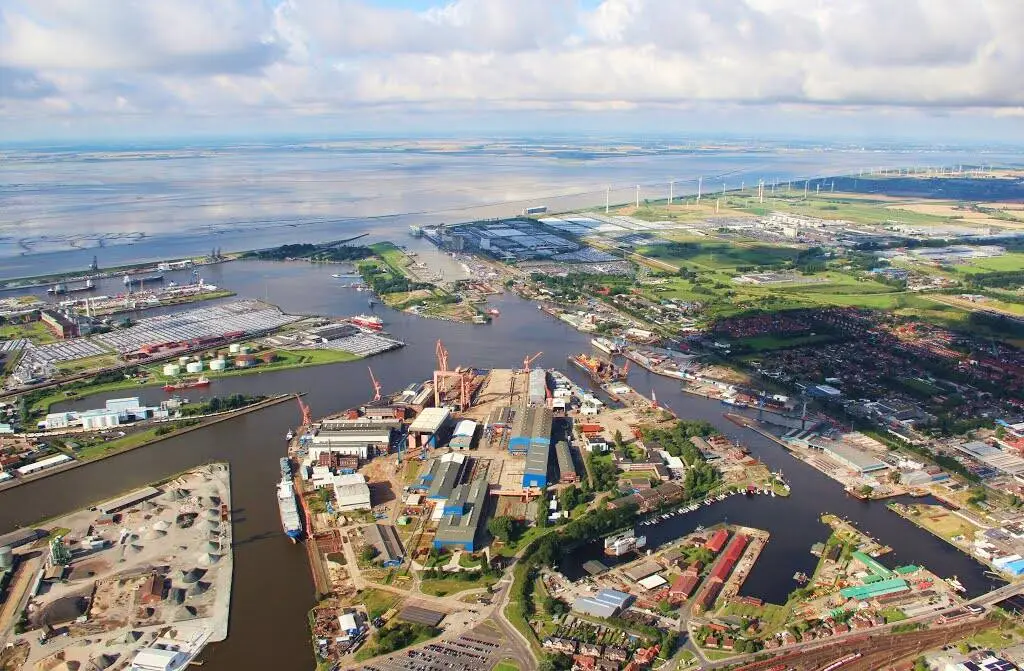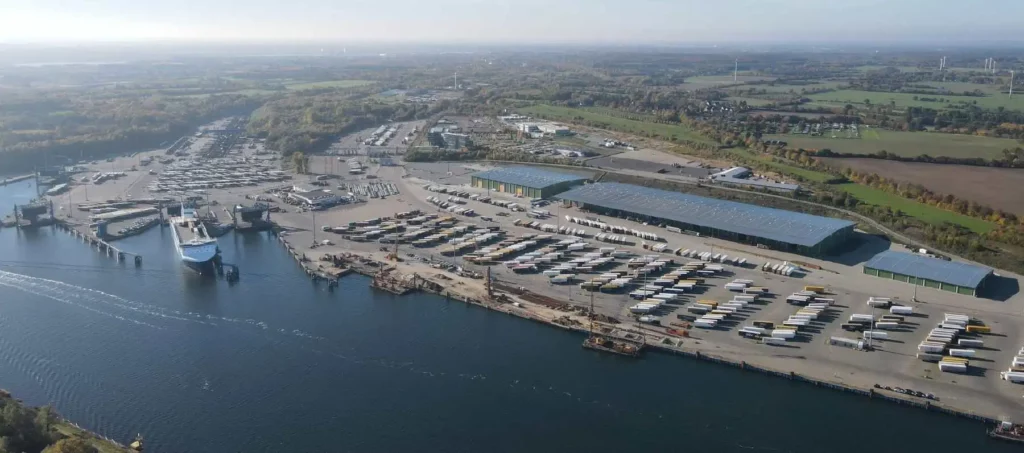Top 10 Major Ports in Germany
Germany isn’t just a powerhouse of industry, it’s a shipping giant! Think towering cranes and bustling docks – that’s the scene at Germany’s top seaports, like Hamburg, Bremerhaven, and Wilhelmshaven. These European heavyweights handle a massive amount of cargo, from everyday goods to towering vehicles, acting as key hubs connecting Europe, Asia, and North America.
But these ports are more than just shipping centers. They’re vital lifelines for the global maritime industry, offering crucial services like ship repair, maintenance, and supplies. Their efficiency directly impacts how smoothly goods flow around the world.
Intrigued by the engines driving German trade? Dive deeper into the top 10 German seaports and their roles in shaping the global shipping landscape!
1. Hamburg Port

Known as Germany’s “Gateway to the World”, the Hamburg port is the largest port in Germany in terms of volume.
Regarding TEU, Hamburg is the third busiest port in Europe (after Rotterdam and Antwerp) and the 15th largest seaport in the world. Around 25% of internal shipping activities are located in Hamburg’s port, a key link between Eastern and Central European regions.
Key Information:
- UN LOCODE: DE HAM
- Berthing Volume: 320
- Total area: 7250 Hectares
- Container Traffic: 9.3 Million TEU
- Container Tonnage: 136.6 Million Tons
- Top Exports: Aircraft, mineral oil products, gold for industrial purposes, chassis, engines
- Top Imports: Office and automatic data processing machines, cars, packages, medicaments, etc.
- Major trading partners: United States, France, Turkey, Netherlands, and Hungary
2. Port of Bremen and Bremerhaven

The trading ports of Bremen and Bremerhaven are collectively referred to as the Ports of Bremen or Bremish Ports. These ports are among the biggest Ports in Germany. The port of Bremen, the largest industrial hub in Germany, is located on the Weser River’s edge, about 70 kilometers inland from the North Sea.
Bremen Ports GmbH & Co. KG, a private position on public property, manage them. The port built its first stone wall in 1032 as its trade with the Netherlands, Norway, and England began to grow.
Key Information:
- UN LOCODE: DEBRE
- Container Traffic: 5.2 Million TEU
- Container Tonnage: 69,695 Million Tons
- Major imports: Motor cars, caravans, aircraft, coffee, engines
- Major exports: Cars, ships, boats, measuring and automatic control instruments
- Major trade partners: United Kingdom, China, Russia, Poland, Netherlands
3. Port of Wilhelmshaven

The Wilhelmshaven port is the only deepwater port and is located between the Ems and Weser rivers on the western embankment of the Jade Delta. Wilhelmshaven Port is a medium-sized port when it comes to Ports in Germany. This port is hidden behind a two-chamber sea lock and is divided into an inner harbor that is tide-independent and an external deepwater port with unusual transshipment bridges.
Wilhelmshaven’s port is well-equipped with the newest harbor infrastructure for the transshipment of containers, refrigerated cargo, food, bulk cargo, project cargoes, and general cargo.
Key Information:
- UN LOCODE: DEWVN
- Container Traffic: 656,000 TEU
- Container Tonnage: 350,000 tons
- Major Exports: Petroleum products, LPG, liquid chemicals, scrap, and containerized cargo
- Major Imports: Crude oil, steam coal, chemicals, fertilizers, perishable foodstuffs, timber, salt
- Major trade partners: US, China, France, UK, Netherlands
4. Port of Duisburg

The quays in Duisburg-Ruhrort, the largest river harbor in the world, stretch nearly 40 kilometers along the river. It is situated in Duisburg, West Germany, about 20 kilometers north of Düsseldorf. Between the Ruhr Channel and the Rhine River at kilometers (774 and 781) is where this port is located.
The main inland shipping port in Germany is Duisburg-Ruhrort. In terms of all public and private port amenities, it is also recognized as the largest inland port in the world and the largest inland port in Europe. Approximately 1.5 million m2 of covered storage space is available at these locations. The hub for the pan-European canal connecting Amsterdam, Hamburg, Emden, Antwerp, and Rotterdam seaports is the port of Duisburg-Ruhrort.
Key Information:
- UN LOCODE: DE DUI
- Container traffic: 4.1 million TEU
- Container Tonnage: 111.1 million tons
- Major exports: German car parts, wines, textiles, clothes, and toys
- Major imports: Coal, oil, chemicals, scrap, metal industry additives, and building materials
- Top trade partners: Italy, Austria, Poland, US, UK, CHINA
5. Port of Rostock

The port of Rostock, Germany’s fourth-largest port, is well on its way to overtaking the other Baltic seaports. Thanks to its advantageous geographic location, both on land and at sea.
Key Information:
- UN LOCODE: DERSK
- Container traffic: 28.8 million TEU
- Container tonnage: 25.1 million tons
- Major exports: Forest products, sugar, coal, ores, steel products, scrap
- Major imports: Coal, building materials, fertilizer, grain, metals
- Major trade partners: China, US, Netherlands, Italy, UK
6. Port of Emden

The third-largest port in Germany, the Port of Emden, is situated close to East Frisia’s North Sea shore, next to the Ems River, in northwest Germany. It is one of Germany’s most prominent and busiest tide-free inland ports. The port is one of the biggest sea locks that is open 24/7.
Key Information:
- UN LOCODE: DEEME
- Container traffic: 13100 TEU
- Container Tonnage: 26836 tons
- Major export: Cars, forest products, pulp and paper, timber, grains, bulk goods for construction
- Major imports: Crude oil, coal metal, steel
- Major trade partners: US, UK, China, Poland, Italy
7. Port of Lubeck

The most isolated southwestern transportation hub is the Lubeck port, located on the Baltic Sea coast. It acts as a primary sound system for congestion between the quickly developing BSR countries and the traditional economic center in central or western Europe. It has an extensive network of direct facilities serving the region.
Due to the port’s borderland connections, the tonnage can reach its destination in several practical ways. The A1 motorway’s three lanes connect Lubeck with Europe’s key economic centers. The rail network offers excellent competence in terms of carload and combined congestion.
Key Information:
- UN LOCODE: DELBEC
- Container Traffic: 117000 TEU
- Container tonnage: 1.4 million tons
- Major imports: Paper, containers, automobiles, trucks, heavy goods
- Major exports: Sugar, grains, fruit, cars, metals, steel
8. Port of Kiel

The port of Kiel, which includes the route to the bars at the eastern end of Kiel Canal, is essential for passenger and cargo traffic. It is located in the inner section of the Baltic Sea Bay Kieler Forde. The port is one of the Baltic region’s most diverse ports.
The port is particularly appealing for its population density and cargo due to its geographic location, consistent depth for seagoing vessels, and direct access to the national railway and road network.
Key Information:
- UN LOCODE: DEKEL
- Container tonnage: 7.1 million tons
- Container traffic: 20000 TEU
- Major imports: Building materials, coal oil products
- Major exports: metal, sugar, steel, cars, gold
- Major trade partners: Belgium, China, US, UK, Switzerland
9. Port of Frankfurt

Germany’s Frankfurt Port is a medium-sized port. Due to their strategic locations and the alluring views of the Main (river) from the urban setting, its different inshore ports have transformed over time into new uptown areas.
Key Information:
- UN LOCODE: DEFRA
- Container tonnage: 4.3 million tons
- Container traffic: 64,794
- Major imports: Packaged medicaments, motor vehicles, vaccines, blood, etc.
- Major exports: Chemical products, cars, machinery
- Major trade partners: US, UK, Italy, China, India, Poland, Netherlands
10. Port of Brunsbuttel

The Port of Brunsbuttel is located close to the North Sea and at the Elbe River’s mouth. In the northern German state of Schleswig-Holstein, it serves as a point of entry to the Kiel Canal.
This port can handle a variety of commodities, including chemical containers, oil and gas containers, dry cargo, and dangerous items like explosives due to its proximity to a well-established industrial region.
Key Information:
- UN LOCODE: DEBRB
- Inner Harbor: 656 feet and 1640 feet long (Has its own coaling station connected to the inner harbor)
- Warehouse space: 27.9 thousand square meters
- Outdoor storage: 233.9 thousand square meters
- Major exports: Motor vehicles, machinery, aircraft, coal
- Major imports: Grains, sugar, chemical products, oil base products
Looking for a hassle-free shipping process with complete visibility on the movement of your cargo?
Fix a free walkthrough demo of how GoComet’s solution can give you a 100 percent multi-modal supply chain visibility and help you drive double-digit cost savings in your supply chain, while eliminating all the pain points you may currently face due to the lack of automation.
FAQs about Ports in Germany
What is Germany’s biggest port?
The biggest port in Germany is the Port of Hamburg. It is the country’s largest port and one of the busiest in Europe. It handles a wide variety of cargo, including containers, bulk goods, and vehicles, and serves as a major hub for trade between Europe, Asia, and North America. The port features state-of-the-art infrastructure and equipment and is home to a large number of shipping companies, freight forwarders, and other logistics providers. It also plays a significant role in the maritime industry, providing services such as ship repair, maintenance, and supply.
How many sea ports are there in Germany?
Germany has a total of about 80 seaports, including major ports, minor ports, and specialized ports. Out of these, the major ports are Hamburg, Bremerhaven, and Wilhelmshaven, which handle the majority of the country’s sea trade and are considered the most important ports of Germany. These ports are well-equipped with state-of-the-art facilities and are capable of handling large volumes of cargo including containers, bulk goods, and vehicles. Additionally, there are several minor ports that are specialized and mainly dedicated to a specific type of cargo, for example, terminals for roll-on/roll-off cargo, liquid bulk cargo, or general cargo.
What are the major ports in Germany?
The major ports in Germany are Hamburg, Bremerhaven, and Wilhelmshaven.
What kind of cargo do these major ports handle?
These major ports handle a wide variety of cargo, including containers, bulk goods, and vehicles.
How do these major ports in Germany impact global trade?
These ports serve as important hubs for trade between Europe, Asia, and North America, and are vital for the smooth and timely movement of goods around the world.
What infrastructure and services do these major German ports provide for the maritime industry?
These major ports provide state-of-the-art infrastructure and services for the maritime industry, such as ship repair, maintenance, and supply. They also feature advanced equipment and facilities for handling and storage of various types of cargo.
